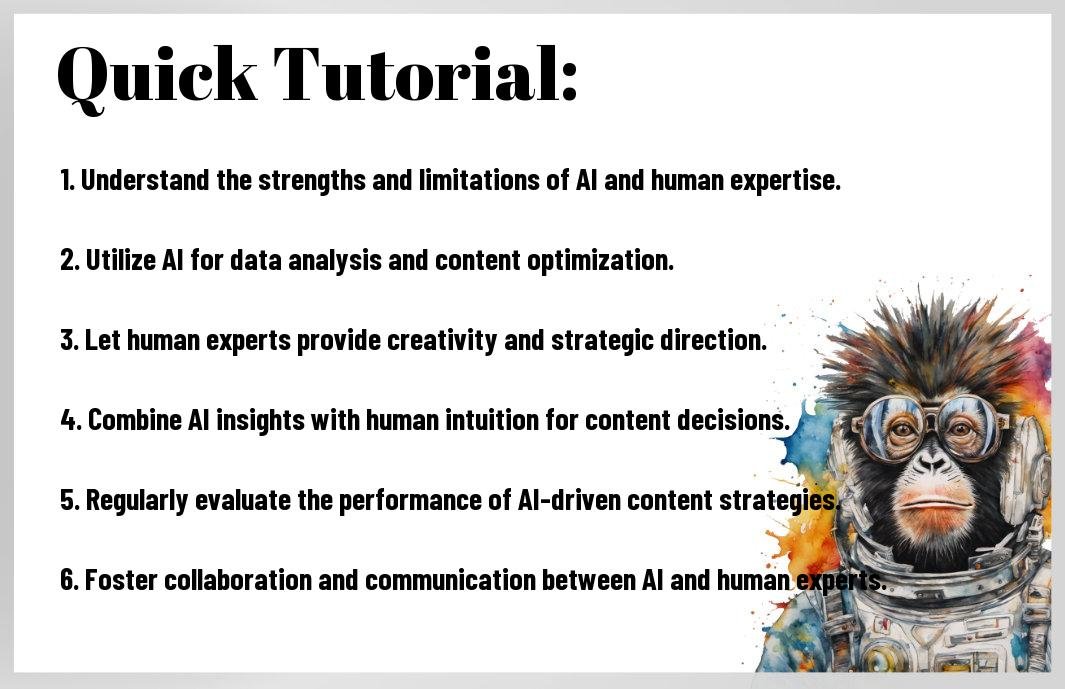Conjoining human expertise and artificial intelligence in content strategy can yield exceptional results, given the right approach. In this top 10 listicle, we will explore the most effective practices for seamlessly integrating human creativity and AI capabilities to enhance content strategy. By leveraging the unique strengths of both human professionals and AI technology, businesses can achieve a harmonious blend of creativity, efficiency, and strategic insight in their content creation and distribution efforts. Let’s delve into the best practices for achieving this successful combination.
Key Takeaways:
- Clear Understanding: It is essential to have a clear understanding of the strengths and limitations of both human expertise and AI in content strategy to effectively combine the two.
- Collaborative Approach: The best practice involves a collaborative approach where human experts work alongside AI to leverage the strengths of both for more comprehensive and effective content strategy.
- Data-Driven Insights: AI can provide valuable data-driven insights that can aid human experts in making informed decisions, while human expertise can provide contextual understanding and emotional intelligence that AI may lack.
- Continuous Learning and Adaptation: Content strategy teams should prioritize continuous learning and adaptation to stay updated with the latest advancements in AI technology and best practices for utilizing it in conjunction with human expertise.
- Evaluating Performance: Regular evaluation of the combined efforts of human expertise and AI is crucial to refine and improve the content strategy, ensuring that the collaboration remains effective and delivers the desired results.

Understand Goals
Before integrating human expertise and AI into your content strategy, it’s important to understand the goals you want to achieve. This involves defining objectives and setting measurable outcomes to ensure that the combination of human and AI efforts align with your overall business objectives.
Define objectives
The first step in understanding your goals is to define clear objectives for your content strategy. These objectives should be specific, measurable, achievable, relevant, and time-bound (SMART). Whether it’s increasing brand awareness, driving website traffic, or improving engagement, having well-defined objectives will guide the collaboration between human expertise and AI in achieving the desired outcomes.
Set measurable outcomes
For the collaboration between human expertise and AI to be effective, it’s essential to set measurable outcomes that can be tracked and analyzed. This involves identifying key performance indicators (KPIs) that directly align with your defined objectives. By establishing measurable outcomes, you can evaluate the impact of the combined efforts, optimize the content strategy, and make data-driven decisions that drive results.
With the right objectives in place, the combination of human expertise and AI can lead to impactful content strategies that drive business growth and deliver value to your audience.
Choose Right AI Tools
Some of the best practices for combining human expertise and AI in content strategy involve choosing the right AI tools. With the plethora of AI tools available in the market, it’s crucial to select the ones that align with your specific content strategy goals and are equipped to seamlessly integrate with your team’s expertise.
Evaluate tool efficiency
The first step in choosing the right AI tools is to evaluate their efficiency in meeting your content strategy needs. It’s essential to assess how well the AI tool can handle tasks such as content creation, curation, and personalization. Additionally, consider the tool’s ability to streamline workflows, automate mundane tasks, and provide valuable insights through data analysis. By carefully evaluating the efficiency of AI tools, you can ensure that they complement and enhance the expertise of your content strategy team.
Verify data security
To maintain the integrity of your content strategy, it’s imperative to verify the data security measures employed by AI tools. Ensuring that the AI tools adhere to industry standards for data privacy and security is crucial for safeguarding sensitive information and maintaining the trust of your audience. Look for features such as encryption, access controls, and compliance certifications to verify the data security measures implemented by the AI tools. By prioritizing data security, you can confidently integrate AI into your content strategy without compromising the protection of valuable data.
It’s essential to prioritize data security when evaluating AI tools for content strategy, especially in industries where compliance and privacy regulations are stringent. By verifying the data security measures of AI tools, you can mitigate potential risks and demonstrate a commitment to protecting sensitive information, which is paramount in today’s digital landscape.

Train Teams Appropriately
Not only is it important to have the right tools in place for combining human expertise and AI in content strategy, but it is equally crucial to train teams appropriately to effectively utilize these tools. This is particularly essential in ensuring that your team fully understands the capabilities and limitations of AI in content strategy. For more information on this topic, you can check out 9 Strategies to Use Content AI in Your Workflow.
Educate on AI capabilities
Teams should be educated on the specific capabilities of AI within the context of content strategy. This includes understanding how AI can assist in data analysis, trend identification, and content optimization. It is important for team members to recognize the areas in which AI can enhance their work and contribute to better content outcomes.
Encourage continuous learning
To ensure that teams are making the most out of AI in content strategy, encourage continuous learning and ongoing education related to AI technologies and best practices. Keeping up with the latest developments in AI and content strategy will allow teams to adapt and evolve their strategies in line with industry advancements.
Any team member involved in content strategy should be willing to embrace continuous learning and stay updated with the latest AI-powered content tools and techniques. This will contribute to enhanced collaboration between human experts and AI, leading to more effective content strategy outcomes.
Combine Strengths
To effectively harness the power of both human expertise and AI in content strategy, it is paramount to combine their respective strengths. By leveraging human creativity and utilizing AI for data, companies can achieve a harmonious balance that maximizes the potential of their content strategy.
Leverage human creativity
For content strategy, human creativity is indispensable. Humans have the ability to think outside the box, understand complex emotions, and adapt to ever-changing trends. By leveraging human creativity, companies can create compelling and authentic content that resonates with their target audience. This human touch adds depth and authenticity to content, making it more engaging and relatable.
Utilize AI for data
Leveraging AI for data analysis and insights can provide invaluable support to content strategy. AI has the capacity to process and analyze massive sets of data at a speed and scale that surpass human capabilities. By utilizing AI for data, companies can uncover valuable trends, patterns, and audience insights that inform content strategy decisions. This data-driven approach enables more targeted and effective content creation, distribution, and optimization.
To effectively implement AI for data analysis, companies can leverage machine learning algorithms to identify content performance patterns, automate content personalization, and predict audience behavior. Through AI, content strategists can gain comprehensive insights into audience preferences, engagement metrics, and content performance, allowing for informed decision-making and continuous improvement of content strategy.
Regularly Monitor Performance
Now that you have implemented a content strategy that combines human expertise and AI, it is crucial to regularly monitor its performance. This allows you to identify areas for improvement, optimize your strategies, and ensure that your content continues to meet the needs of your audience.
Analyze content impact
For a comprehensive understanding of your content strategy’s effectiveness, it is essential to analyze the impact of your content on your target audience. Utilize AI tools to track key performance indicators such as engagement, conversion rates, and audience demographics. Additionally, consider leveraging human expertise to interpret qualitative data, such as customer feedback and sentiment analysis, to gain insights into the emotional impact of your content.
Adjust strategies timely
The dynamic nature of content consumption and audience preferences necessitates the need to adjust strategies timely. By continuously monitoring the performance of your content strategy, you can identify emerging trends, shifts in audience behavior, and areas for improvement. Human experts can provide valuable insights into consumer behavior and industry developments, which when combined with AI-driven analytics, can inform timely adjustments to your content strategies.
As content strategy is an ever-evolving field, adapting to changes in consumer behavior and technological advancements is crucial to maintaining relevance and effectiveness. Utilizing a combination of human expertise and AI allows for agile and informed adjustments that align with the evolving landscape of content consumption and audience preferences.
Foster Collaboration
Keep human expertise and AI working together harmoniously by fostering collaboration among team members. A successful content strategy combines the strengths of both human and AI knowledge, and promoting teamwork is essential to achieving this synergy.
Promote team input
Collaboration is key when it comes to integrating human expertise and AI in content strategy. Encourage team members to contribute their unique insights and ideas, leveraging the power of collective intelligence. By promoting open communication and brainstorming sessions, you can tap into the diverse skill sets and knowledge of your team, creating content that is both informed and innovative.
Integrate feedback loops
An effective way to combine human expertise and AI in content strategy is to integrate feedback loops that allow for continuous improvement. This involves collecting and analyzing feedback from both human users and AI algorithms, using the insights gained to refine and optimize content strategy. By leveraging feedback loops, you can ensure that the human-AI collaboration is constantly evolving and adapting to meet the needs and preferences of your audience.
This iterative process of integrating feedback loops is crucial for refining content strategy and enhancing the effectiveness of both human expertise and AI. By closely examining user feedback and algorithm insights, content creators can make data-driven decisions and continuously improve their strategies, ensuring relevance and quality in their content.
Stay Informed on Trends
Your content strategy should be informed by the latest trends and developments in the field. It’s important to stay up to date with the latest insights on how AI and human expertise can be combined effectively in content strategy. For more information on this topic, check out Balancing AI and Human Insight in Modern SEO Strategies.
Observe AI advancements
Informed decision-making in content strategy requires staying up to date with the latest developments in AI. By observing AI advancements, you can better understand how to integrate AI technologies with human expertise to optimize your content strategy.
Adapt to market changes
Staying informed about market changes is crucial for maintaining a successful content strategy. By staying aware of market shifts, you can adapt your content strategy to meet the evolving needs and expectations of your audience, thus enhancing your overall content performance.
This proactive approach ensures that your content remains relevant and competitive in the ever-changing digital landscape, allowing you to leverage both human expertise and AI to achieve your strategic goals effectively. Staying informed and adapting to market changes are essential components of a successful content strategy.
Maintain Ethical Standards
After learning about the best practices for using AI in your content strategy, it’s important to consider the ethical implications of combining human expertise with AI. Maintaining ethical standards throughout the content creation process is essential for building trust with your audience and upholding the integrity of your brand. To dive deeper into this topic, you can read our blog post on Best Practices for Using AI in Your Content Strategy.
Uphold transparency
An essential aspect of combining human expertise and AI in content strategy is to uphold transparency. This means clearly disclosing when AI technology is being used in content creation and being honest about the capabilities and limitations of AI. By providing transparency, you can build trust with your audience and demonstrate a commitment to ethical practices in content strategy.
Transparency also includes being open about the ways in which human expertise is integrated with AI, ensuring that the roles and contributions of both are clearly defined. This level of transparency not only builds credibility but also helps to set realistic expectations for your audience.
Prioritize user privacy
Prioritize the protection of user privacy when combining human expertise and AI in content strategy. This involves ensuring that any data collected or utilized in the content creation process is done so in compliance with relevant privacy regulations. Maintaining the privacy and security of user data is crucial for building trust and credibility with your audience. By prioritizing user privacy, you demonstrate a commitment to ethical conduct and responsible use of AI in content strategy.
To wrap up
Hence, the best practices for combining human expertise and AI in content strategy involve leveraging the strengths of both to create a comprehensive and effective approach. This includes using AI to analyze data and provide insights, while relying on human expertise to interpret and apply these insights in a meaningful way. Collaboration and communication between human and AI are crucial in order to ensure that the content strategy is aligned with both the needs of the audience and the goals of the organization. By following these best practices, organizations can harness the power of AI while still benefiting from the unique perspective and creativity that only humans can provide.
FAQ
Q: Why is combining human expertise and AI important in content strategy?
A: Combining human expertise and AI in content strategy allows for a synergistic approach, leveraging AI’s ability to process large amounts of data and human expertise’s ability to provide context, creativity, and nuance.
Q: What are the key benefits of combining human expertise and AI in content strategy?
A: By combining human expertise and AI, organizations can achieve more personalized, relevant, and effective content, improve efficiency in content creation and distribution, and gain deeper insights from data-driven decision making.
Q: How can AI be used to support human expertise in content strategy?
A: AI can be used to analyze data patterns, identify trends, personalize content recommendations, and automate repetitive tasks, allowing human experts to focus on strategic planning, creativity, and building meaningful connections with audiences.
What are the challenges of integrating human expertise and AI in content strategy?
A: Challenges include ensuring ethical and unbiased AI use, overcoming resistance to change, integrating AI seamlessly into existing workflows, and maintaining a balance between automation and human touch in content creation.
Q: What are the best practices for successfully combining human expertise and AI in content strategy?
A: Best practices include fostering a culture of collaboration and learning, providing training and tools to support both human and AI capabilities, continuously evaluating and refining the integration process, and prioritizing transparency and accountability in decision making.





